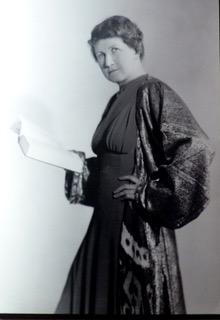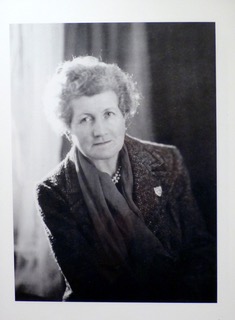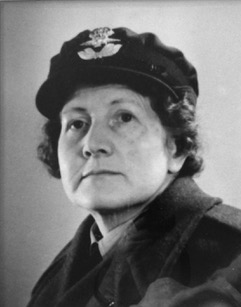Amice Calverley was a passionate woman of many talents who was greatly admired during her brief life. Born into a musical and artistic family in London, England, her family lived in South Africa for a brief time, before eventually settling in Oakville, Canada in 1912. Her ancestors include the English naturalist Osbert Salvin, who was one of two editors of the Biologia Centrali-Americana, a 52-volume encyclopedia on the flora and fauna of Mexico and Central America. Calverley’s mother taught her art, and her talents in drawing would later prove pivotal in her career choice.
While in Oakville, Calverley studied composition with celebrated Canadian composer Healey Willan at the Toronto Conservatory of Music; all of her work from this time has been entrusted to the Canadian Music Centre (Toronto) by her niece, Sybil Rampen. Calverley worked for a time as a seamstress in New York, and her skill in that field can be seen in this beautiful golden coat, which she designed and created. She returned to England in 1922, when she won a scholarship to study at the Royal College of Music. While there, Calverley studied with Ralph Vaughan Williams and composed an opera (which is still awaiting a premiere).
Not long after, Calverley met the archaeologist Leonard Woolley, who suggested that she pursue a career in archaeology rather than music. Calverley began working at the Ashmolean Museum in Oxford, ultimately leading to her assignment to record the decorations in King Sethos I’s tomb in Abydos Egypt. Her work attracted the attention of American philanthropist John D. Rockefeller, Jr., who helped to fund further undertakings at the tomb, which Calverley was in charge of. The resultant work, which is perhaps Calverley’s greatest opus, was published in four volumes (she was working on the fifth and sixth books at the time of her death).
But Calverley’s work in Egypt was not limited to just the scientific aspect of documenting the tomb’s frescoes or even in running the camp there. She took a profound interest in all those around her, befriending her neighbors and local villagers. She offered a clinic a few times a week (after long hours working in the tomb) where locals could come for simple medical treatments – by this time, Calverley already had experience as a nurse from working in a hospital during the First World War. Calverley’s knowledge of Egypt and the area also aided her in the Second World War, when she worked for the Women’s Auxiliary Air Force; according to Rampen, Calverley’s knowledge was key in the Allied forces’ victory in the Battle of El Alamein. After the war, she returned to work at Abydos (again, funded by J.D. Rockefeller, Jr.), where she remained until 1948. Calverley then found herself in Greece, where she became involved in the Greek civil war, serving as a nurse on the frontlines and filming a documentary of the war efforts, which was apparently shown to Prince Phillip aboard the Britannia.
Calverley eventually returned to Canada and purchased a home in Oakville in 1940, but that did not stop her adventurous travels. She once took her niece Sybil Rampen and nephew John Calverley to film the Passiontide at the monastery on the Greek island of Patmos (sadly, those tapes have been lost). Calverley also hosted music salons at her home up until her sudden death in 1962 – she suffered an aneurysm while preparing her house for a concert by the famous British cellist May Mukle. Calverley was famously generous with her time, energy, and self; on one occasion, she secured cholera vaccines and distributed them among some 750 British, Americans, and Egyptians living in Abydos. She donated her own bone marrow while in Greece, and worked to secure funding (which she unfortunately did not receive) to help disabled Greek veterans after the war.
A striking woman, Calverley reportedly received 19 marriage proposals by the time she was 31; she only accepted 3, but none of those came to fruition. Calverley seemed destined instead to create her legacy not through descendants, but through her music, her archaeological and cultural pursuits, and her profound interest in humanity and the lives of all whom she touched.
(Much of the information in this article is thanks to our interview with Amice Calverley’s niece, Sybil Rampen. Be sure to check that out here.)
-Daniella Theresia
23 October 2020
Return to podcast. ↵
Can’t get enough?
Visit our Bibliography page for further sources.
Subscribe to our Newsletter!


